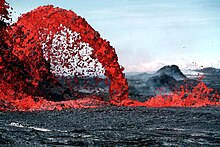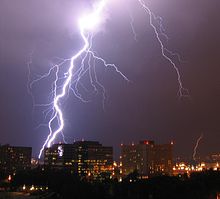Physics (Ancient Greek: φύσις physis "nature") is a natural science that involves the study of matter[1] and its motion through spacetime, as well as all applicable concepts, including energy and force.[2] More broadly, it is the general analysis of nature, conducted in order to understand how the universe behaves.[3][4][5]
Physics is one of the oldest academic disciplines, perhaps the oldest through its inclusion of astronomy.[6] Over the last two millennia, physics had been considered synonymous with philosophy, chemistry, and certain branches of mathematics and biology, but during the Scientific Revolution in the 16th century, it emerged to become a unique modern science in its own right.[7] However, in some subject areas such as in mathematical physics and quantum chemistry, the boundaries of physics remain difficult to distinguish[citation needed].
Physics is both significant and influential, in part because advances in its understanding have often translated into new technologies, but also because new ideas in physics often resonate with other sciences, mathematics, and philosophy. For example, advances in the understanding of electromagnetism or nuclear physics led directly to the development of new products which have dramatically transformed modern-day society, such as television, computers, domestic appliances, andnuclear weapons; advances in thermodynamics led to the development of motorized transport; and advances in mechanics inspired the development of calculus.
Contents[hide] |
Scope and aims
Physics covers a wide range of phenomena, from elementary particles (such as quarks, neutrinos and electrons) to the largest superclusters of galaxies. Included in these phenomena are the most basic objects from which all other things are composed, and therefore physics is sometimes called the "fundamental science".[8] Physics aims to describe the various phenomenon that occur in nature in terms of simpler phenomena. Thus, physics aims to both connect the things observable to humans to root causes, and then to try to connect these causes together.
For example, the ancient Chinese observed that certain rocks (lodestone) were attracted to one another by some invisible force. This effect was later calledmagnetism, and was first rigorously studied in the 17th century. A little earlier than the Chinese, the ancient Greeks knew of other objects such as amber, that when rubbed with fur would cause a similar invisible attraction between the two. This was also first studied rigorously in the 17th century, and came to be called electricity. Thus, physics had come to understand two observations of nature in terms of some root cause (electricity and magnetism). However, further work in the 19th century revealed that these two forces were just two different aspects of one force – electromagnetism. This process of "unifying" forces continues today, and electromagnetism and the weak nuclear force are now considered to be two aspects of the electroweak interaction. Physics hopes to find an ultimate reason (Theory of Everything) for why nature is as it is (see section Current research below for more information).
The scientific method
Physicists use the scientific method to test the validity of a physical theory, using a methodical approach to compare the implications of the theory in question with the associated conclusions drawn from experiments and observations conducted to test it. Experiments and observations are to be collected and matched with the predictions and hypotheses made by a theory, thus aiding in the determination or the validity/invalidity of the theory.
Theories which are very well supported by data and have never failed any competent empirical test are often called scientific laws, or natural laws. Of course, all theories, including those called scientific laws, can always be replaced by more accurate, generalized statements if a disagreement of theory with observed data is ever found.[9]
Theory and experiment
Main articles: Theoretical physics and Experimental physics
Theorists seek to develop mathematical models that both agree with existing experiments and successfully predict future results, while experimentalists devise and perform experiments to test theoretical predictions and explore new phenomena. Although theory and experiment are developed separately, they are strongly dependent upon each other. Progress in physics frequently comes about when experimentalists make a discovery that existing theories cannot explain, or when new theories generate experimentally testable predictions, which inspire new experiments.
Physicists who work at the interplay of theory and experiment are called phenomenologists. Phenomenologists look at the complex phenomena observed in experiment and work to relate them to fundamental theory.
Theoretical physics has historically taken inspiration from philosophy; electromagnetism was unified this way.[10] Beyond the known universe, the field of theoretical physics also deals with hypothetical issues,[11] such as parallel universes, a multiverse, and higher dimensions. Theorists invoke these ideas in hopes of solving particular problems with existing theories. They then explore the consequences of these ideas and work toward making testable predictions.
Experimental physics informs, and is informed by, engineering and technology. Experimental physicists involved in basic research design and perform experiments with equipment such as particle accelerators and lasers, whereas those involved in applied research often work in industry, developing technologies such as magnetic resonance imaging (MRI) and transistors. Feynman has noted that experimentalists may seek areas which are not well explored by theorists.[citation needed]
Relation to mathematics and the other sciences
In the Assayer (1622), Galileo noted that mathematics is the language in which Nature expresses its laws.[12] Most experimental results in physics are numerical measurements, and theories in physics use mathematics to give numerical results to match these measurements.
Physics relies upon mathematics to provide the logical framework in which physical laws may be precisely formulated and predictions quantified. Wheneveranalytic solutions of equations are not feasible, numerical analysis and simulations may be utilized. Thus, scientific computation is an integral part of physics, and the field of computational physics is an active area of research.
A key difference between physics and mathematics is that since physics is ultimately concerned with descriptions of the material world, it tests its theories by comparing the predictions of its theories with data procured from observations and experimentation, whereas mathematics is concerned with abstract patterns, not limited by those observed in the real world. The distinction, however, is not always clear-cut. There is a large area of research intermediate between physics and mathematics, known as mathematical physics.
Physics is also intimately related to many other sciences, as well as applied fields like engineering and medicine. The principles of physics find applications throughout the other natural sciences as some phenomena studied in physics, such as the conservation of energy, are common to all material systems. Other phenomena, such as superconductivity, stem from these laws, but are not laws themselves because they only appear in some systems.
Physics is often said to be the "fundamental science" (chemistry is sometimes included), because each of the other disciplines (biology, chemistry, geology, material science, engineering, medicineetc.) deals with particular types of material systems that obey the laws of physics.[8] For example, chemistry is the science of collections of matter (such as gases and liquids formed of atoms andmolecules) and the processes known as chemical reactions that result in the change of chemical substances.
The structure, reactivity, and properties of a chemical compound are determined by the properties of the underlying molecules, which may be well-described by areas of physics such as quantum mechanics, or quantum chemistry, thermodynamics, and electromagnetism.



No comments:
Post a Comment